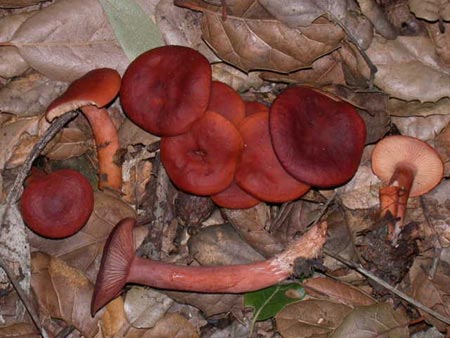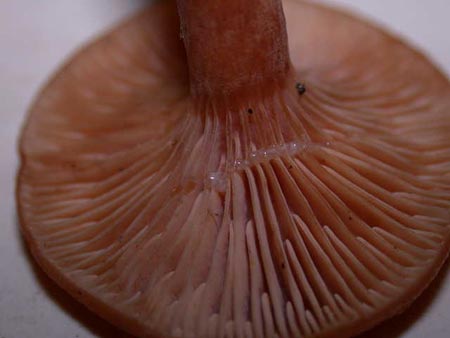Lactarius rubidus and Lactarius rufulus, the “Candy Cap”
There are many species of edible mushrooms that lend themselves to savory dishes, but very few that are used to flavor desserts. Meet our locally common and delightfully fragrant mushroom, the “Candy Cap.” One of the many marvels of mushrooms is that they have so many distinctive fragrances, and the candy cap has one of the sweeter ones: that of maple syrup. This fragrance is faint when the mushroom is fresh in the field, but a slow drying indoors will produce a strong and heady fragrance, powerful enough to perfume an entire room for a year. This fragrance is imparted to foods when used in cooking, and dried mushrooms are often powdered to flavor desserts, or soaked, chopped and cooked to flavor cookies. They also make a delicious counterpoint to savory dishes, especially those using smoked meats.

© photo by Darvin Deshazer
Like all species of Lactarius, this mushroom produces a type of latex, or milk, when cut or bruised. The color of the latex, or the way that the latex changes color when exposed to the air, is a major part of the identification of Lactarius species. Latex colors within this genus can range from red to orange to blue to yellow to white. In the case of Lactarius rubidus, the mushroom produces pale white milky latex that often has a skim-milk consistency.
Another diagnostic characteristic of Lactarius (and Russula) species is the presence of rounded cells called sphaerocysts. These cells cause the tissue of the mushroom to be brittle and easily broken, and one of the ways that you can determine if you have a lactarius in hand is that the stipe will break cleanly, like chalk. Candy caps can have either a hollow or solid stipe, but they will always snap, unless they are rotten or have squirmy prior occupants, in which case you are hopefully going to reject them for the table anyway.
There are a number of small, brownish-orange mushrooms out there, so how best to safely determine that what you have picked is indeed a candy cap? If you take the time to carefully examine each mushroom (a vital process if you are hunting for the table) candy caps have a number of features which, if present in combination, can cinch your ID. Here in the Bay Area, candy caps can occur under both pine and live oak. Lactarius rubidus is often an attractive burnt-orange color. Lactarius rufulus, the larger, less fragrant candy cap species that occurs exclusively under oak, tends to have a redder cap. When fresh and moist, they should both bleed pale white latex that can quickly fade to a skim milk consistency. They will often smell faintly of maple syrup. And, as Darvin DeShazer pointed out to me, they even feel different: if you rub your finger lightly over the cap surface, it will feel nubbly, not smooth like some of their unpalatable look-alikes. The stipe should snap cleanly, like chalk (with the above caveats in mind). If your mushroom has all of these features, it is indeed a candy cap, and you are in for a culinary treat.

© photo by Darvin Deshazer
Hunting candy caps is not without its hazards, however. Here in the East Bay, they tend to occur in conjunction with our native blackberries, whose discrete thorns appear harmless, until you kneel on them or attempt to brush the vines aside with your bare hands. Like the glocids on a cactus, these tiny spines can remain in your flesh for months, reminding you to be more careful in your future harvest attempts. And of course, bare branched but still potent poison oak is a constant presence during the winter in candy cap habitat. Use caution, or suffer the rash consequences!
It is a lot of stoop labor to collect quantities of these small mushrooms, so the commercial price is correspondingly high. I have seen them for sale in local markets (Berkeley Bowl and Monterey Produce) and they are appearing ever more frequently on restaurant menus, where they are primarily used in desserts. John Pisto, a mushroom-loving chef from Monterey, uses candy caps in a number of lovely savory dishes, and includes several candy cap recipes in his fine cookbook, “Cooking with Mushrooms.”
As with all edible wild mushrooms, it is vital that you practice quality control, both in the field, in the stores, and at home. Only choose mushrooms for the table that are in impeccable shape, both firm to the touch and visibly free of bugs (snap the stipe and look for tunnels). The gills of a candy cap start to discolor as they age, so I only select mushrooms whose gills are a uniform pale orange; rotten mushrooms are not edible mushrooms. A candy cap that is drying in the field and no longer bleeds latex can still be edible, as long as there is no sign of bugs or rot, and you are confidant of your ID. It is also important that you process your carefully harvested mushrooms as soon as possible, since they are highly perishable, and unlike us, bacteria and mushroom maggots never sleep.
Sadly enough for our myco-friends in the Mid-West and the North-East, candy caps do not occur in their parts of the country. After a good year of collecting here in California, I make it a point to send candy cap care packages back East. They cause much appreciation amongst my friends, and much confusion amongst the postal workers (the fragrance of candy caps is so strong that the whole package smells like maple syrup!).
So enjoy the hunt, relish your finds and be grateful if you live in California, where the livin’ and mushroomin’ is easy. And remember to hunt mindfully and share what you collect, because food tastes better in the company of friends, and good manners makes for a better society, whether in the concrete jungle or in the wild, wild woods.
© Debbie Viess

 back to top
back to top